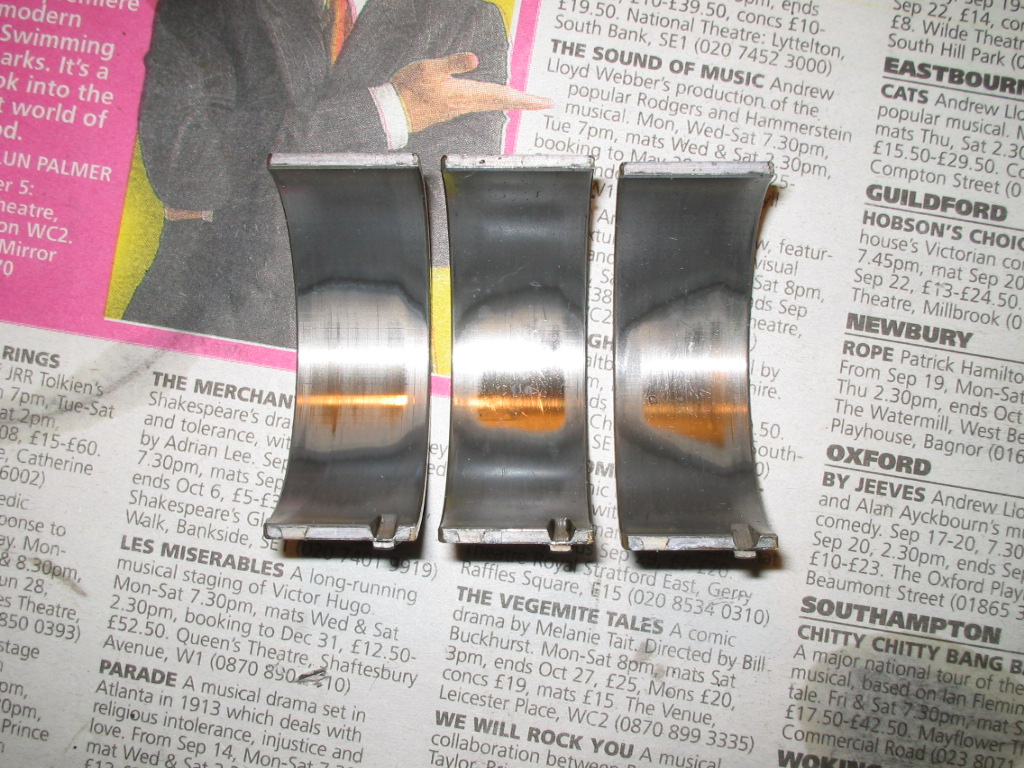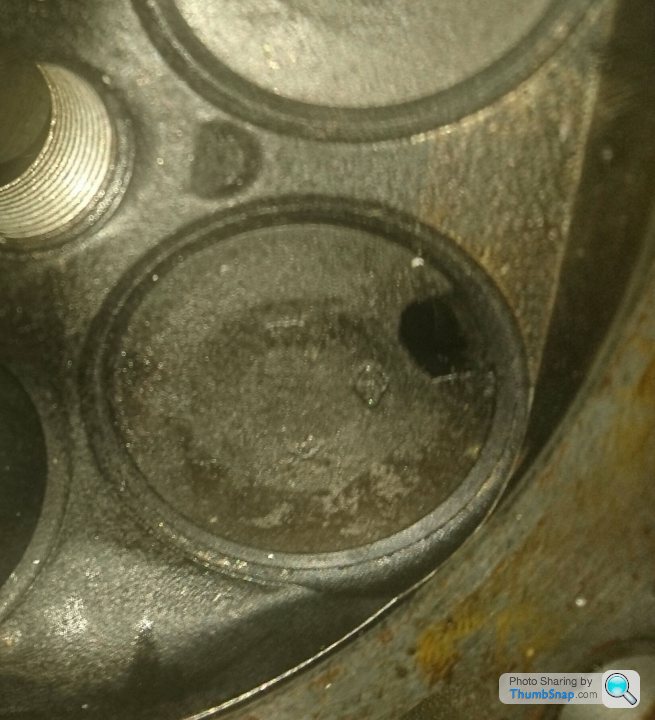Tagless Big End Bearing Shells
Discussion
227bhp said:
Oh dear, did you find it? 
The other pistons are displaying signs of det at the bottom there (probably caused by the oil contamination), is that det' opposite the corresponding squish pad on the head?
No, other pistons are fine, that's just debris. Engine does have a knock sensor, the failure came completely without warning (no power loss or audible pinking) and was over within 3 or 4 seconds.
The other pistons are displaying signs of det at the bottom there (probably caused by the oil contamination), is that det' opposite the corresponding squish pad on the head?
Bore scoring means the engine was scrapped. I'm in the process of replacing the timing and oil chain mechanisms of a replacement that lasted about 2 miles after fitting. I think I still have compression as it didn't die when one of the chains started flailing around, currently stopped in my tracks by a stubborn crank bolt - they're always stubborn aren't they?!?
ukkid35 said:
Pic from a previous M160, I didn't take a photo of the lower shells, I guess they looked OK to an amateur like me

If those are the upper shells it looks like metal to metal contact only at tdc when piston accelerations are highest. Quite unusual though.
Edited by ukkid35 on Saturday 3rd December 10:19
ukkid35 said:
Looking at the photos again (from the comfort of my sofa), perhaps I'm being unrealistic thinking I can replace the upper shells from underneath, access is pretty limited. And I'm 99% certain that it's the upper shells that will be suffering.

Quite easy, poke a screwdriver in and spin the bearing round till it falls out, push new one in the same way but not with screwdriver.
You'll need small hands though and the bearings with tabs would make locating a bit safer.
227bhp said:
Quite easy, poke a screwdriver in and spin the bearing round till it falls out, push new one in the same way but not with screwdriver.
You'll need small hands though and the bearings with tabs would make locating a bit safer.
I do have delicate hands, but the Smart is small (200cc combustion chamber vs typical 500cc). Also not sure how other shells are fitted, but these are sprung, so popping them out with a screwdriver is unlikely to work.You'll need small hands though and the bearings with tabs would make locating a bit safer.
Interesting bearing wear, my first thoughts are rod distortion too, be interested to see the back of those bearing shells.
King race bearings are very popular in race engines now as the supply of ACL has dried up or is of questionable source. Interesting to hear what Mignon said about Ali faced bearings, have always run a mile from them in performance applications.
Would like fire you a question Mignon, after some advice. PM me if your interested in helping.
King race bearings are very popular in race engines now as the supply of ACL has dried up or is of questionable source. Interesting to hear what Mignon said about Ali faced bearings, have always run a mile from them in performance applications.
Would like fire you a question Mignon, after some advice. PM me if your interested in helping.
227bhp said:
First thoughts are rod distortion, but things are seldom that simple....
I'd say almost certainly not because the only forces acting on rods to create ovality in the housing pull the sides in which increases contact there rather than at top or bottom. You end up with rods which are smaller across the split line and longer top to bottom. There is obviously a greater tendency for big end shells to wear at top and bottom (TDC and BDC) than for mains where the forces are more evenly distributed throught the piston stroke. This is rather more pronounced than I am used to seeing though.Very strange wear pattern! Almost as if foreign material has been laying beneath each bearing shell, bang in the middle. Or, the journals are out of round...
Latter wouldn't surprise me to be honest; any engine which requires twin spark plugs points towards compromised and cheap design.
Latter wouldn't surprise me to be honest; any engine which requires twin spark plugs points towards compromised and cheap design.
It should be fairly simple to change upper shells even on a small bore engine. Bring a piston to BDC and take the cap off. Remove that girdle plate thing if it gets in the way. Push the rod back up a bit and push against the shell with a thumb on the side that doesn't have the tab. It should just push round and out and slide underneath the journal. Feed the new shell back in the same way until the tab engages.
Evoluzione said:
Utilising twin spark is quite the opposite of compromise and poor design.
An optimised combustion chamber does not require the use of twin spark plugs. It is usually a last resort to solve a detonation problem, typically associated with combustion chambers without a centralised spark plug.
HJG said:
Evoluzione said:
Utilising twin spark is quite the opposite of compromise and poor design.
An optimised combustion chamber does not require the use of twin spark plugs. It is usually a last resort to solve a detonation problem, typically associated with combustion chambers without a centralised spark plug.
It's just another addition like water injection or anything else which improves matters, it doesn't mean the original design was flawed at all. Detonation will always occur if you make it by pushing the boundaries and it's more likely on a 2vpc head.
What you are saying is that a company like Mercedes with it's vast amount of knowledge and resources somehow managed to mess up the combustion chamber so it wouldn't work properly. Their only response was to ignore the chamber design and everything else they could do, but actually redesign the head and engine to take another spark plug?
Bonkers.
It's likely to be a SOHC engine so couldn't have a central plug anyhow.
ukkid35 said:
Oil means it runs hot, exhaust valves don't stand a chance.
The motormouth that runs a popular Smart 'technical' website likes to tell people that, but in practice it's down to the oil burning causing carbon deposits on the valve seats. As soon as this happens the valve stops sealing properly and quickly burns out.HJG said:
An optimised combustion chamber does not require the use of twin spark plugs.
It is usually a last resort to solve a detonation problem, typically associated with combustion chambers without a centralised spark plug.
It is usually a last resort to solve a detonation problem, typically associated with combustion chambers without a centralised spark plug.
Edited by Mr2Mike on Sunday 4th December 20:21
Mr2Mike said:
ukkid35 said:
Oil means it runs hot, exhaust valves don't stand a chance.
The motormouth that runs a popular Smart 'technical' website likes to tell people that, but in practice it's down to the oil burning causing carbon deposits on the valve seats. As soon as this happens the valve stops sealing properly and quickly burns out.Also willing to accept that people ignore OCIs and use inferior grades, which is likely to be the ultimate cause.
So having read that interesting article from Kings about bearing material, would the conventional (tri-metal) or aluminium bearings be better suited for the following engine (4AGE 20v) :
NA
Iron block
1600 cc
Bore 81mm
Stroke 77 mm
Peak torque @ 5,600 rpm
Peak power (165 hp) @ 7,800 rpm
8,300 rpm redline
Factory spec for big end clearance : 12-12 thou
The engine has burned oil since the last rebuild (replacement crank due to keyway damage); I recently destroyed an exhaust valve, so am replacing the valves and rings (at least ), and maybe bearings while it's apart.
), and maybe bearings while it's apart.

NA
Iron block
1600 cc
Bore 81mm
Stroke 77 mm
Peak torque @ 5,600 rpm
Peak power (165 hp) @ 7,800 rpm
8,300 rpm redline
Factory spec for big end clearance : 12-12 thou
The engine has burned oil since the last rebuild (replacement crank due to keyway damage); I recently destroyed an exhaust valve, so am replacing the valves and rings (at least
 ), and maybe bearings while it's apart.
), and maybe bearings while it's apart.
ukkid35 said:
Perfectly happy to accept that explanation.
Also willing to accept that people ignore OCIs and use inferior grades, which is likely to be the ultimate cause.
One of the contributors to oil burning in the Suprex engine is failure of the PCV valve, which is very common. They fail in an open position which allows boost pressure to enter the crankcase, and oil is then forced up past the rings. The resulting carbon causes the rings to stick (further increasing oil consumption) and eventually the exhaust valves get burnt.Also willing to accept that people ignore OCIs and use inferior grades, which is likely to be the ultimate cause.
Treat the PCV as a service part, change the oil regularly and ensure both spark plugs on each cylinder get replaced when they should and these little engines can last a good while. It seems many/most of them are ignored until they go wrong.
Gassing Station | Engines & Drivetrain | Top of Page | What's New | My Stuff



